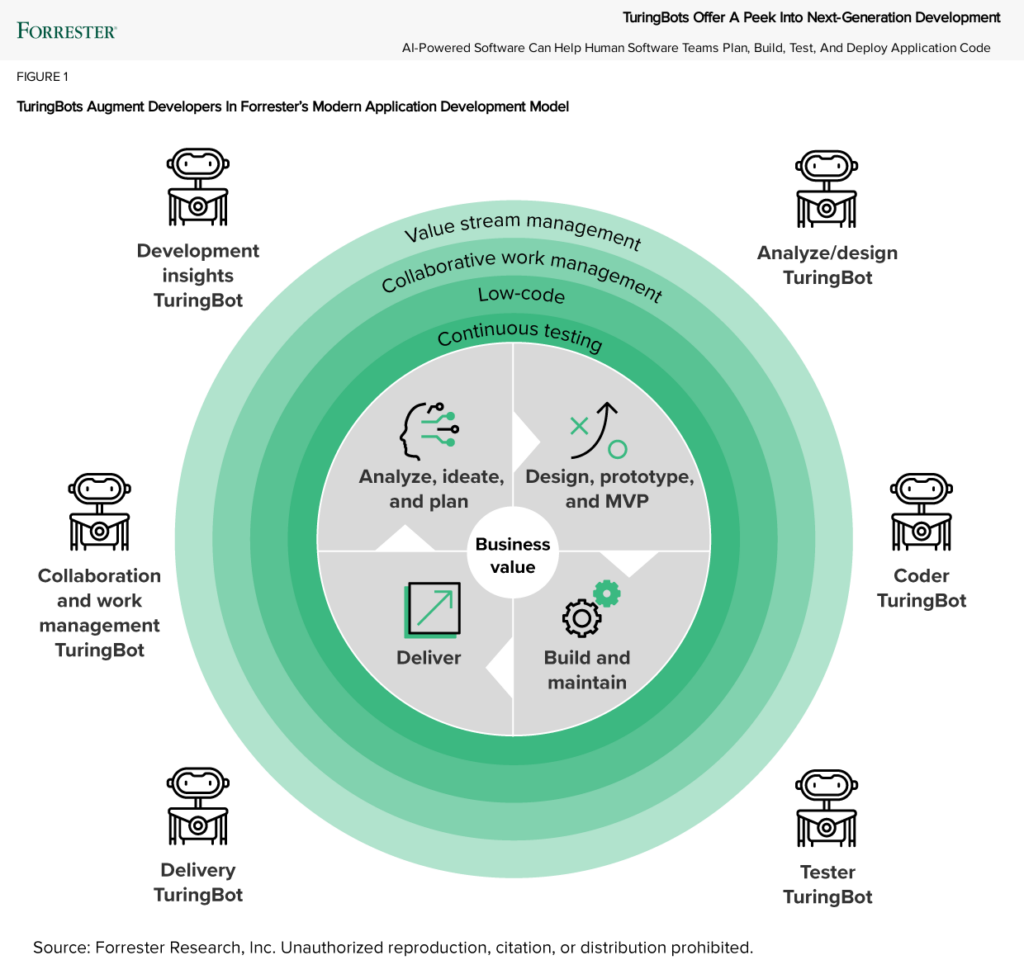The Next Generation Of Modern Software Development Is Here: Embrace It Or Die
Generative AI TuringBots speed and improve software development. But the siren song of generative AI to build and deploy applications in seconds challenges tech executives to identify realistic opportunities. Short-term, TuringBots will assist all dev roles. Midterm, TuringBots will become better peers to humans and more accurate. Long-term, they will become more autonomous with additional reasoning capabilities and human supervision (still), but productivity will reach unimaginable heights.
Hold On … But What Are TuringBots?
Forrester defines TuringBots as:
AI-powered software that augments application development and infrastructure and operations teams’ automation and semiautonomous capabilities to plan, analyze, design, code, test, deliver, and deploy while providing assistive intelligence on code, development processes, and applications.
TuringBots can support product development teams and their developers through most stages of the software development lifecycle: from analysis design to deployment.

Two of the TuringBots category have a broader vendor and product ecosystem that organizations have been using; they are either experimenting more with these tools and/or are building real apps and products. One of them is the coder TuringBot that can assist developers in generating code from “prompts” and or “comments,” and the other one is the tester TuringBot that can help test smarter, supporting test automation and more.
OK, So They Are About Productivity and Creativity, But …
If you are a technology executive, you should care about TuringBots, since they are among The Top 10 Emerging Technologies In 2023 (see report) that will impact enterprises’ technology choices now and in the next few years. However, while TuringBots are an important game-changer technology that increases teams’ productivity and creative thinking by freeing them up from repetitive and boring work, challenges and risks are behind the corner, too. So technology executives have to think hard about their opportunities and key use cases to employ this emerging technology, as well as the guardrails that they should put in place to prevent IP loss or insecure and poor-quality products from reaching production. What will be the impact on skills, and will TuringBots affect in some way the planning and management of future development resources? If you want some answers, and more, to these questions, join us at the Technology & Innovation EMEA Forum in London this year.
Join Us At T&I Forum To Hear More
At this year’s T&I EMEA this coming October, you’ll have many opportunities to dive into generative AI for development. In my keynote, as well as a fireside chat with guest speaker Mark Burnett, head of the Technology Innovation Group at G-Research, we will share takeaways for technology executives to learn how to plan an adoption roadmap of TuringBots and align key practices, governance, and benefits. Gain more about TuringBots by also attending a track session with Martha Bennett and I: Will Generative AI TuringBots Replace Your Teams In Building Better Software Faster? Points, Counterpoints, And The Truth. I am looking forward to seeing you all there. If you can’t come, reach out with a guidance session, inquiry, or briefing with me; email me at dlogiudice@forrester.com if you would like to dig deeper into the future of software development with TuringBots.
